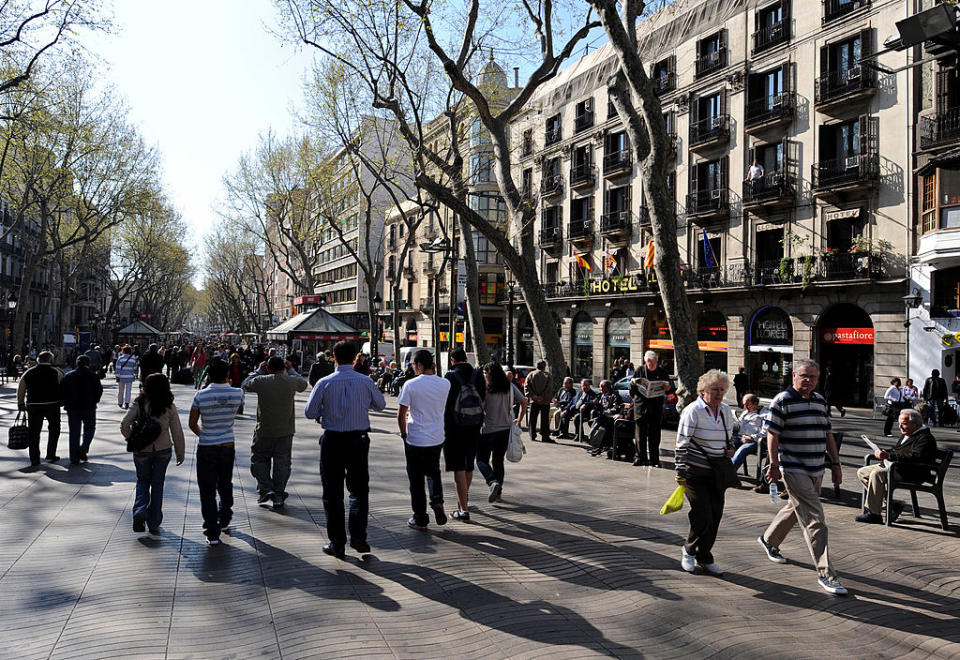Las Ramblas is the economic, touristic and symbolic heart of Barcelona – and it will continue to be so

It should come as no surprise that terrorists deciding to attack a target in Spain would choose Barcelona’s Las Ramblas. The driver of a van deliberately ploughed into a crowd of pedestrians, killing at least 14 people, and injuring more than 100 in the horrific incident. Beyond the immediate horror, the attack is likely to have consequences for the area.
Barcelona is Spain’s second largest city and the sixth most inhabited area in the EU. Perhaps more significantly, it is a global tourism hotspot. A total of 18 million tourists visited the region in 2016, with 9 million staying in the city’s hotels – an increase of more than 7 million since 1990. At the heart of this renaissance has been the celebrated street.
Las Ramblas (Les Rambles in Catalan) is a tree-lined boulevard that stretches across the heart of the city, with space for pedestrians along its centre and cars on either side. The street forms Barcelona’s historical centre, tracing the lines of an ancient seasonal watercourse visible in old maps.
The area is often the first destination for new arrivals in the city, given its proximity to some of the major tourist locations. It’s a good way to get to the Gothic Quarter, the marina and the seafront. A number of theatres and museums are situated on, or just off, Las Ramblas and a pavement mosaic by Barcelona-born artist Joan Miró can be found along its route.
It’s also an important ideological centre. It leads to the Plaça de Catalunya (Catalonia Square), which is seen by pro-independence residents as the city’s main square, rather than Plaça de’Espanya (Spain Square).
This is a reminder of the difficult situation Spain now finds itself facing. An attack on Barcelona raises questions not only about how to respond, but also who should respond. There is a long-running constitutional tension between the local Catalan administration and the central Spanish government, with the former seeking to hold an independence referendum in October. The two take different approaches to all kinds of issues and terrorism is potentially one of them – not forgetting Spain’s lengthy struggle with its own terrorist group ETA. The leaders will now have to work together to decide how to react to this crisis.
A symbolic site
Over the years, Las Ramblas and the Plaça de Catalunya have been the scene of anticlerical violence, Spanish Civil War clashes, and socio-political demonstrations. In many ways, Las Ramblas is the emotional heart of Barcelona, representative of the city itself – its people and their struggles.
The Las Ramblas traders showed their entrepreneurial spirit and flexibility in the way that, over the past few decades, they have shifted their focus away from traditional local markets towards a more diverse tourist market. The boulevard is lined with souvenir kiosks, street performers and pavement cafés these days. More traditional markets are still there too, including fresh fruit, vegetables, meat and fish – but the difference is notable.
Adapting to tourism has brought its problems too. Crowds flock to Las Ramblas throughout the day. The boulevard heaves with people from early morning to late at night and pickpockets are a notorious problem. There has recently been fierce debate about the impact so many visitors have on the local life of Barcelona.
This week brought things into perspective though. The crowded street was evacuated within minutes and the normally bustling markets fell silent. Local people and tourists gathered together in a vigil after the attacks in a moment of stillness rarely seen on the busy thoroughfare.
Barcelona is Spain’s economic powerhouse. The 1888 Barcelona Universal Exposition and the 1929 Barcelona International Exhibition catapulted the regional capital onto the world stage and it really became a major tourist location after hosting the 1992 Olympics. But of all the sectors of Barcelona’s diverse economy, the attacks have the potential to hit tourism the hardest.
Nowhere is more intertwined with the city’s tourist industry than Las Ramblas. In true Barcelona fashion, the boulevard reopened for business just 24 hours after the attacks. The message was a vital one: incidents of this kind, however horrifying, must not destroy a way of life.
Mark McKinty is an Early Career Researcher in Spanish Studies, Queen's University Belfast. This piece originally appeared on The Conversation

 Yahoo Sport
Yahoo Sport 





































